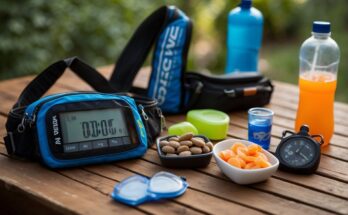Ultra running can seem daunting, with its demanding terrain and extended distances. Whether you’re already signed up or merely contemplating an ultra, insights from seasoned athletes can make a significant difference.
Key Takeaways
- Set specific goals and align your training to the course
- Use technology to enhance training and race day performance
- Focus on efficiency and technique for better hill running
Top Tips for Ultra Running
Goal Setting and Training
Set clear goals for your ultra run. Plan your training around these goals, focusing on specificity. For terrain replication, print and laminate the course profile of your race. Use a treadmill set to the right incline and speed to mimic the actual race conditions.
Terrain Replication for Training
If you can’t access the actual race terrain, think creatively. Use treadmill incline settings or local hills to simulate the course profile. Regularly review and adjust your training to stay aligned with the upcoming race.
Trail Running Technique
Keep your head up and eyes looking forward. This helps maintain balance and reduces the risk of tripping. Pace according to how you feel and adapt to varying trail conditions.
Pacing Strategy
Combine pace and feel during training. Use tools like PacePro to understand your movement on different terrains. Maintain an even effort and keep some energy in reserve for the final stages of your run.
Uphill Running Technique
Focus on efficiency. Increase cadence with shorter steps, use arm drive to propel yourself, and look up to keep your posture straight and make breathing easier. Use real-time climb data to stay motivated.
Navigation Skills
Always use map features on your watch to avoid getting lost. Knowing your location and route is crucial, especially in long races. It ensures every step you take is toward the finish line.
Nutrition and Hydration Plans
Create a detailed nutrition and hydration plan. Use alerts on your watch to remind you to eat and drink regularly. Tailor your intake to your personal needs and ensure consistency throughout the race.
Motivation and Consistency
In the challenging world of ultra running, maintaining motivation and consistency in training is crucial. Tom Evans emphasizes the importance of setting specific goals. “Once your goal has been set, you can then plan your training around that.” He suggests replicating the race terrain as closely as possible, even if it means using a treadmill with the appropriate incline and speed settings.
Tips for Consistent Training:
- Set Specific Goals: Identify your race and tailor your training to match the course profile.
- Use Visual Aids: Print and laminate the course profile to use on a treadmill.
- Adapt When Necessary: If you can’t train on the actual terrain, simulate it with available resources.
Evans also highlights the importance of mental strategies to stay motivated when the going gets tough. Keeping the training interesting and varied can help. This approach not only boosts physical preparedness but also builds mental resilience.
Strategies to Stay Motivated:
- Variety in Training: Mix up your workouts to prevent monotony.
- Mental Visualization: Use visual aids to mentally prepare for the race.
- Focus on Progress: Celebrate small achievements and improvements.
By integrating these techniques, runners can enhance their consistency and maintain high levels of motivation, essential for tackling the demanding nature of ultra running.
Leveraging Technology
Training Aids
Using technology in training can significantly enhance performance and preparation for ultra-running races. One of the key tools mentioned is the laminated course profile which can be used on a treadmill. By adjusting the incline and speed to match the profile, runners can simulate race conditions. This aids in replicating the specific terrain of the upcoming race, even if terrain like that isn’t locally accessible.
Additionally, pace and effort monitoring tools such as PacePro help runners understand and adjust their speed according to the terrain. This combination of pace and feel allows for more tailored training sessions, helping runners save energy for critical moments and maintain a consistent effort throughout their runs.
Racing Applications
During races, technology can help runners navigate and manage their physical efforts more effectively. ClimbPro is one feature that provides real-time updates on the remaining climb, which can motivate runners by giving them clear, actionable data on how much longer they need to push. It also assists in pre-race preparations by allowing runners to preview the race route.
Moreover, maps and navigation features are essential to avoid getting lost, which is critical in long races. These tools give runners assurance about their location and progression, helping them stay on course.
Finally, hydration and nutrition alerts remind runners to fuel and hydrate at regular intervals, crucial for maintaining performance and preventing fatigue. This reminder system ensures runners do not forget to eat or drink, particularly in sections of the race where it might be easy to neglect these needs.
Conclusion and Final Tip
Setting a specific goal is crucial. With a clear objective, it’s easier to plan and tailor the training. Replicating the race terrain in training can be a challenge, especially if the course is far from home. A practical tip is to print out and laminate the course profile, then use it on a treadmill with the correct incline and speed.
When running on trails, maintaining an upright posture and looking forward helps. Slowing down for tricky sections and not worrying about pace is beneficial. Pacing is critical and utilizing features like “pace pro” can enhance understanding of effort levels over different terrains.
For uphill running, increasing cadence, driving arms, and looking up are effective techniques. Navigation tools like maps on a watch prevent getting lost, especially in long races. Proper hydration and nutrition are vital. Gentle reminders from a watch can ensure consistent intake, essential for endurance events. Lastly, remembering to enjoy the process and keep improving technique and efficiency will enhance the overall ultra-running experience.




